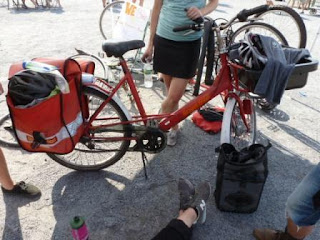 |
| This happened at a bicycle race in Matamoros, Mexico on 1 June 2008. One cyclist was killed. Ironically, "Matamoros" means "Kill Moors" in Spanish. (From VeloWorld) |
A few years ago, a man used his SUV to run over five people on Long Island after getting into a fight with one of them. He fled the scene of the accident.
Tell me: What's wrong with the above passage?
It's in the last word: accident. The last time I checked my Oxford English Dictionary, none of the definitions of the word "accident" included intention, volition or causality. Perhaps I should look again, just in case my memory is getting fuzzy.
Yet no less than the New York Times--and, presumably, the Nassau County Police Department-- used that word to characterize the incident.
Now, you might say that my perceptions are colored (clouded?) by being a writer and English instructor. Still, I contend that words are powerful, and the ones that are chosen shape the way people perceive whatever is being described. And people's responses, or lack of them, are a result of their perceptions.
The Long Island man's use of his SUV as a weapon of mass destruction certainly wasn't the first--and probably won't be the last--time such an incident is referred to as an "accident." It's also not the only kind of non-random collision that has been, or will be, so misnamed.
About two years before the Long Island incident, rapper Foxy Brown is said to have hit two cyclists on West Houston Street in Manhattan. She originally claimed that her former friend, Ayesha Quattara, was at the wheel, but the testimony of the cyclists who were hit--and Quattara--indicated that the rapper (who is said to be losing her hearing) was the real culprit. Quattara and the cyclists also said that Brown yelled, "Get out of my way, you dumb white faggots!"
That incident was also listed as an accident (and her friends claimed that she is neither a racist nor a homophobe). Now, she probably didn't intend to run them down. However, Brown herself admitted she was agitated as she was racing from one Louis Vuitton store to another before it closed. So the incident can't be called an "accident" that "happened."
Calling such incidents "accidents", by implication, lessens the culpability of the drivers involved. It also, I think, causes detectives and others charged with investigating such incidents to think that they are simply terrible fates that could not have been avoided. I can't help but to believe that anyone who thinks that way will take their investigations less seriously and, perhaps, to be less diligent in them.
On the other hand, if such incidents were classified as (attempted) homicides or negligence, the cops would be right on them. Even classifying what Foxy Brown or her friend did as a hate crime would have gotten it more attention than it got as an "accident".









